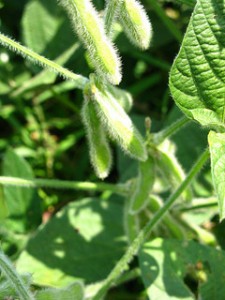A Soybean in the Supreme Court: Bowman v. Monsanto
The idea of patenting a living organism is strange to some people, if not frightening. Nonetheless, these kinds of patents have existed for decades. On Tuesday, the Supreme Court held argument in Bowman v. Monsanto, a case that will test just how far these patents reach.
Vernon Hugh Bowman is a 75-year-old Indiana soybean farmer. Like pretty much every soybean farmer in America, Bowman is a regular purchaser of “Roundup-Ready” soybean seed from Monsanto. Farmers who plant the variety are able to kill weeds, but not soybeans, by spraying their fields with Roundup. Today, over 90% of the soybean crop in the U.S. uses Monsanto’s patented variety.
One special feature of a living thing is that it can grow and reproduce. And so farmers who buy Roundup-Ready soybean seed sign a contract with Monsanto promising that they will not replant any of the soybeans that they harvest. Monsanto wants farmers to buy a fresh batch of seed every time they plant a soybean crop — and not grow their own.
For years Bowman paid his money, signed the contract, planted his Roundup-Ready soybeans, and harvested a nice crop. And then he, like many soybean farmers, decided to plant a second crop in the same growing season. The second crop is riskier (cooler weather and lower soil moisture often reduce yields). And so rather than purchase a second round of expensive seeds from Monsanto, Bowman went to a grain depot — basically, a huge pile of seeds of low quality, used usually for animal feed — and bought a batch of bulk soybeans. Bowman knew that a lot of what he bought would inevitably be Roundup-Ready, given Monsanto’s huge market share.
He planted the seed and harvested a crop. And Monsanto sued, arguing that by growing the soybeans Bowman had made unauthorized copies of Monsanto’s patented product.
Bowman’s principal legal defense is the “patent exhaustion doctrine.” Patent exhaustion is what enables you to buy a car or computer containing many patents and then sell it to someone else. The idea is that once a good is sold by a maker, the patent is “exhausted” and the maker has no rights in further uses or sales. In the Supreme Court, Bowman argued that this rule allowed him to buy patented seeds from another farmer and plant them.
But unlike a car, a soybean seed is self-replicating. And so, argued Monsanto, the act of planting the soybean is tantamount to copying. Just as you can’t make a copy of a Cadillac you legally bought and sell that, you can’t make copies of Roundup-Ready soybeans and sell them. Patent exhaustion doesn’t mean the freedom to copy.
In the Supreme Court this week, several justices seemed to agree with Monsanto. “Why in the world,” Chief Justice Roberts asked, “would anybody spend any money to try to improve the seed if as soon as they sold the first one anybody could grow more and have as many of those seeds as they want?” Justice Sotomayor struck a similar tone: “The exhaustion doctrine permits you to use the good that you buy,” she said. “It never permits you to make another item from that item you bought.”
Yet from Bowman’s perspective, all he did was do what farmers have done for generations: buy bulk seed from other farmers and plant it. And since Roundup Ready soybeans aren’t a different color or affixed with a label, there is really no way to just buy non-Roundup Ready seeds in bulk.
The central problem, in short, is that living things breed. And when they do so, they make copies. As patents on living organisms proliferate — consider patented animals, of which there are many already — the question of how to balance the needs of the patent system with the freedom to engage in time-honored and natural activities is going arise time and again. Bowman v. Monsanto is just the first battleground.


Comments